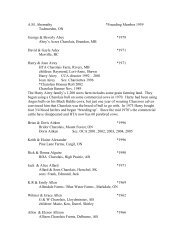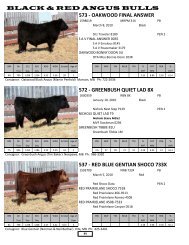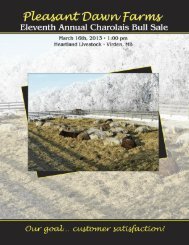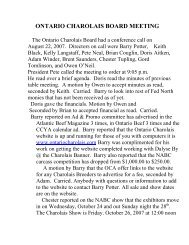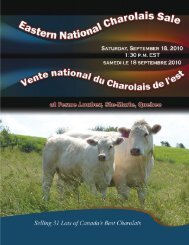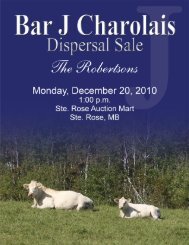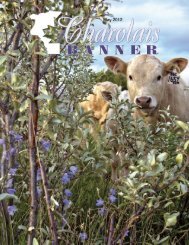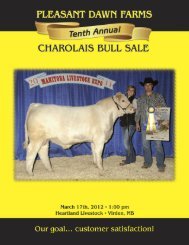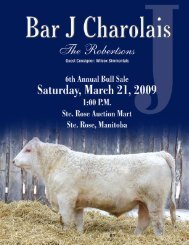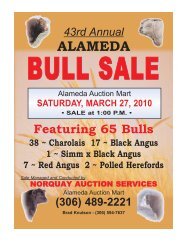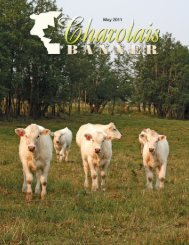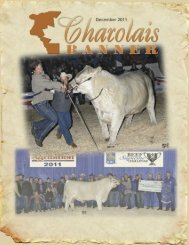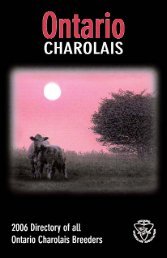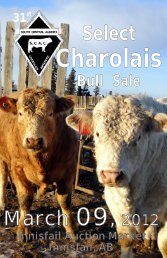You also want an ePaper? Increase the reach of your titles
YUMPU automatically turns print PDFs into web optimized ePapers that Google loves.
minutes in a cow and 60 minutes in a<br />
heifer – then examine her to<br />
determine if presentation is normal.<br />
Wash the vulva, anus, and the area in<br />
between using soap and warm water.<br />
Using a disposable sleeve (shoulder<br />
length) and a good lubricant (usually<br />
available from your veterinarian),<br />
insert your hand slowly and do not<br />
rupture the waterbag. If the calf’s<br />
presentation is not an anterior (Figure<br />
1) or posterior position (Figure 3) or<br />
if the calf is very large or the heifer<br />
small, you may want to seek<br />
professional help.<br />
Proper Placement of Obstetrical<br />
Chains<br />
To properly use obstetrical chains<br />
when assisting with a difficult birth,<br />
follow the example in Figure 4. To<br />
attach the chain, loop it around the<br />
thin part of the leg above the fetlock.<br />
Then, make a half hitch and tighten it<br />
below the joint and above the foot.<br />
Make certain that the chain is<br />
positioned in such a manner that it<br />
goes over the top of the toes. In this<br />
way the pressure is applied so as to<br />
pull the sharp points of the calf’s<br />
hooves away from the soft tissue of<br />
the vaginal wall.<br />
Forced Extraction of the Calf<br />
It is very important at all times to<br />
exert pressure only when the animal<br />
strains and to relax completely when<br />
the patient relaxes. The old idea of<br />
maintaining a steady pressure during<br />
assistance is wrong, unless the cow<br />
has already given up and no<br />
assistance is coming from her.<br />
Excessive or improper pressure<br />
often causes injuries to the dam such<br />
as vaginal tears, uterine rupture,<br />
paralysis, or uterine prolapse. All can<br />
usually be prevented but when they<br />
occur they need the immediate<br />
attention of your veterinarian.<br />
Vaginal tears generally heal with<br />
proper antibiotic therapy. Uterine<br />
rupture usually results in death. Some<br />
animals will recover from calving<br />
paralysis but may require prolonged<br />
care and may not breed again.<br />
Pulling on a calf should only be<br />
done when the presentation and<br />
posture of the calf are normal. This<br />
applies both to an anterior position<br />
(Figure 1) and a posterior position<br />
(Figure 3). Excess force should never<br />
be used in pulling a calf. In most<br />
cases, no more than two men should<br />
be allowed to pull and then only<br />
when the cow strains. Lubricant and<br />
patience will often solve the tightest<br />
case. Use extreme caution if a<br />
mechanical puller is being used.<br />
The first step is to examine the cow<br />
to check calf position and determine<br />
if assistance is necessary. It is<br />
generally easier to correct any<br />
abnormal presentation if the cow is<br />
standing. If a cow or heifer will not<br />
get up, she should be so placed that<br />
she is not lying directly on the part of<br />
the calf which has to be adjusted.<br />
Thus, if the calf’s head is turned back<br />
toward the cow’s right flank, the cow<br />
should be made to lie on her left<br />
flank so that the calf’s head is<br />
uppermost. This provides more room<br />
in the uterus for manipulation.<br />
Once the calf is in a correct anterior<br />
or posterior position, delivery will be<br />
easier if the cow is lying down. When<br />
the calf’s limbs are located, find out<br />
whether they are forelimbs or<br />
hindlimbs. To do this start by feeling<br />
the fetlock and moving the hand up<br />
the limb. In the hindlimb the next<br />
joint is the hock with the prominent<br />
point. In the forelimb there is also a<br />
prominent point, the point of the<br />
elbow, but before this is reached one<br />
can feel the knee joint, which is flat<br />
and has no prominences.<br />
The calf may be alive or dead.<br />
Sometimes movements can be<br />
detected in a live calf by placing the<br />
fingers in the mouth, seizing the<br />
tongue, or touching the eyelids.<br />
If the genital passage of the cow is<br />
dry or if the calf itself is dry, plenty<br />
of lubricant should be used. Attempts<br />
to repel (push back) the calf should<br />
be made between labor pains.<br />
Similarly, attempts to deliver the calf<br />
by traction will be a lot easier if they<br />
52 <strong>Charolais</strong> Connection • <strong>February</strong> <strong>2013</strong><br />
are made to coincide with the<br />
contractions of the cow.<br />
Anterior Presentation<br />
An anterior presentation is forefeet<br />
first, head resting on the limbs, and<br />
the eyes level with the knees (Figure<br />
1). As stated above, in this<br />
presentation the cow does not usually<br />
require assistance, unless it is a heifer<br />
at first calving, the calf is dead, or the<br />
calf is too big for the cow.<br />
If the calf is dead, tie a chain<br />
around the head behind the ears and<br />
pass it through the mouth. This will<br />
prevent the head from twisting when<br />
the limbs are being pulled. With a<br />
live calf you can do this by placing a<br />
hand on the head and ensuring that<br />
the head is kept straight. Traction<br />
should not be exerted simultaneously<br />
on the head and limbs until the head<br />
enters the pelvis. A large calf, with



